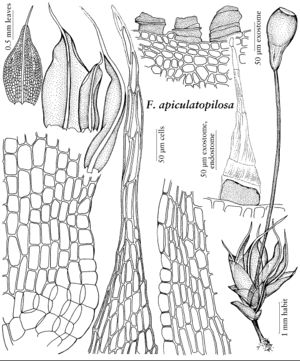Difference between revisions of "Funaria apiculatopilosa"
Rev. Bryol. 40: 37. 1913,.
imported>Volume Importer |
imported>Volume Importer |
||
| Line 51: | Line 51: | ||
|publication year= | |publication year= | ||
|special status= | |special status= | ||
| − | |source xml=https:// | + | |source xml=https://bitbucket.org/aafc-mbb/fna-data-curation/src/2e0870ddd59836b60bcf96646a41e87ea5a5943a/coarse_grained_fna_xml/V27/V27_258.xml |
|genus=Funaria | |genus=Funaria | ||
|species=Funaria apiculatopilosa | |species=Funaria apiculatopilosa | ||
Latest revision as of 21:25, 5 November 2020
Plants 3–5 mm, yellowish green, stem with leaves crowded at the tip forming a bulbiform spiral when dry and bearing a short antheridial branch at the base. Leaves few and reduced proximally, distal leaves 1.7–2.3 mm, concave, the blade ovate to obovate, abruptly contracted to a flexuose, hyaline tipped awn, distal blade margins weakly crenulate to rounded serrate above, entire proximally; costa strong, excurrent with the distal end hyaline; distal laminal cells thin-walled, rhomboid to elongate-hexagonal, proximal cells short-rectangular to almost quadrate toward the margins becoming oblong-rectangular near the costa. Seta usually 3–6 mm, flaring into a slender neck, hygroscopic. Capsule 1.5–2 mm, inclined to arcuate, asymmetric, obovoid, mouth oblique; annulus none; operculum conic-convex; peristome inserted below the rim of the mouth; exostome transparent and papillose, of low, truncate segments about 1/4 the length of the teeth, endostome teeth lanceolate, reddish with a hyaline tip, obliquely papillose-striate to the papillose hyaline tip, trabeculae weakly developed, appendiculae almost absent in the tip. Calyptra cucullate, smooth. Spores 22–30 µm, nearly smooth to papillose.
Habitat: Sand mixed with clay
Elevation: moderate to high elevations
Distribution

Tex., Mexico (Puebla, Zacatecas).
Discussion
Funaria apiculatopilosa is clearly distinct from other exannulate members of the genus in the very long-excurrent sinuose costa with a hyaline tip. The distal leaves spiral around the base of the seta when dry, and are spreading when moist. The trabeculae are thin, lightly pigmented and relatively few, and the spores are thin-walled. It is known from the Davis Mountains in Texas.
Selected References
None.
